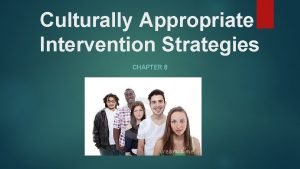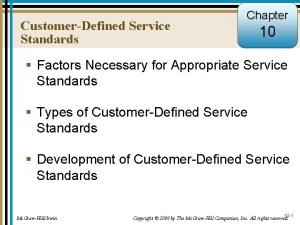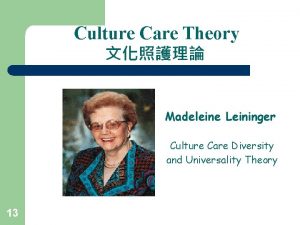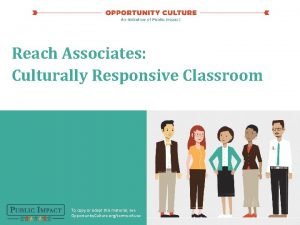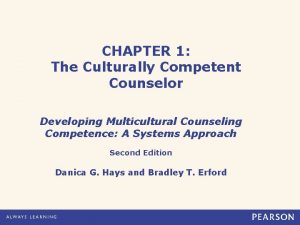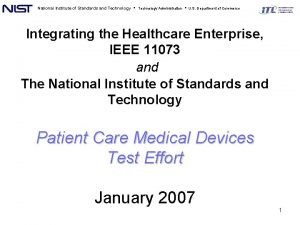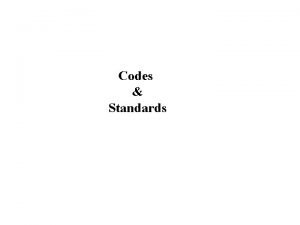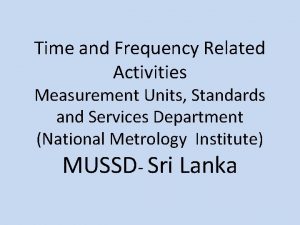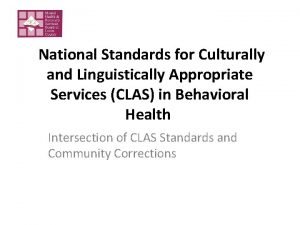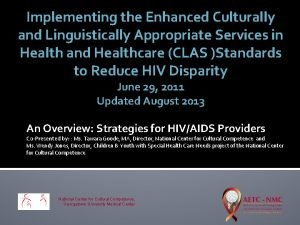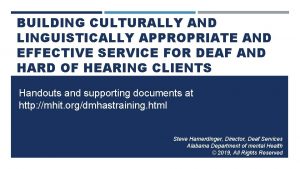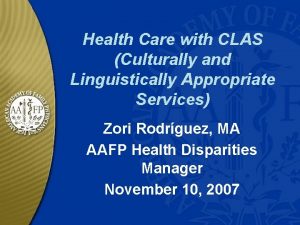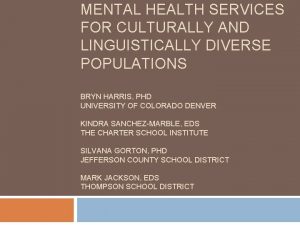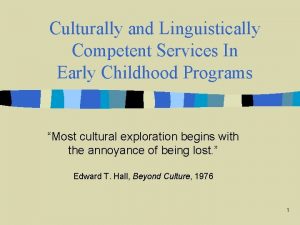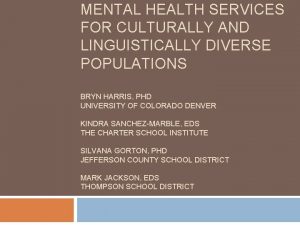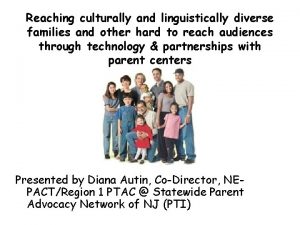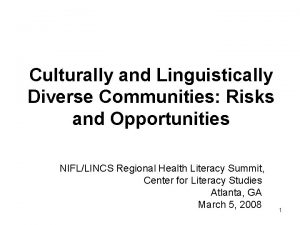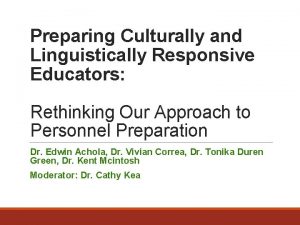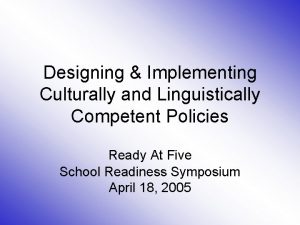National Standards for Culturally and Linguistically Appropriate Services











































- Slides: 43

National Standards for Culturally and Linguistically Appropriate Services in Health Care C. L. A. S. José Tarcisio Carneiro, Ed. D. , M. P. A.

Genesis of CLAS-I • Lack of clear guidance • Several independent standards • Some were too general, too vague, too narrow

Genesis of CLAS-II • 1997 USDHHS/ OMH first steps • 1999 first draft developed • CLAS standards – Federal Register 12 -99 • Regional Meetings (3) – San Francisco, Baltimore, Chicago

Genesis of CLAS-III • 413 organizations/ individuals; hospitals; health professionals; managed care; health agencies • Culturally and linguistically appropriate services (CLAS) January 2000

CLAS Standards The 14 national standards issued by the US Department of Health and Human Services (HHS) Office of Minority Health are intended to: • Ensure that all people entering the health care system receive equitable and effective treatment in a culturally and linguistically appropriate manner • Be inclusive of all cultures • Contribute to the elimination of racial and ethnic health disparities and to improve the health of all Americans

Definition/Classification of CLAS Standards Three types of standards of varying stringency: Mandates… Guidelines… Recommendations…

“CLAS MANDATES” Are current federal requirements for all recipients of federal funds… Standards 4, 5, 6 and 7

“CLAS GUIDELINES” Are activities recommended by OMH for adoption by Federal, State, and national accrediting agencies… Standards 1, 2, 3, 8, 9, 10, 11, 12 and 13

“CLAS RECOMMENDATIONS” Are activities suggested by OMH for voluntary adoption by health care organizations… Standard 14

“USERS” OF CLAS STANDARDS • • Policy makers Accreditation agencies Purchasers Patients Advocates Educators Health care communities

DEFINITIONS OF TERMS • Culture • Competence • Cultural and linguistic competence

“Culture” Culture represents the vast structure of behaviors, ideas, attitudes, values, habits, beliefs, customs, language, rituals, ceremonies and practices “peculiar” to a particular group of people and which provides them with (1) a general design for living, and (2) patterns for interpreting reality. (Nobles)

Cultural Competence IS: • • “Competence” • • Conducting one’s professional work and personal life in the way that members of another cultural group recognize as appropriate. (Adapted from Green, 1982) Interacting with others in a manner that does not disrespect, demean, or otherwise diminish their group, heritage, traditions, beliefs, etc. (Hudson, 1993) A continuing process of growth in knowledge, experience and understanding –it is never perfect or permanent. One’s ability to successfully coexist as human beings. (Mohamed, 1995)

Cultural Competence is NOT: • • • “Competence” • Simply a function of knowledge about different groups, Based only on transient experience with other groups, (e. g. some of my friends are…) Trying to become a member of another culture by adopting that group’s values; beliefs; customs or manners of speaking, dress, or behavior. Such behavior is not a form of respect, and is generally “manipulative and patronizing. ” (Lynch & Hanson, 1992; Green, 1982). A Destination, but a Journey.

Linguistic Competence: • “Linguistic Competence ” • • The capacity of an organization and its personnel to communicate effectively, and convey information in a manner that is easily understood by diverse audiences including persons of limited English proficiency, those who have low literacy skills or are not literate, and individuals with disabilities. Linguistic competency requires organizational and provider capacity to respond effectively to the health literacy needs of populations served. The organization must have policy, structures, practices, procedures and dedicated resources to support this capacity.

Cultural Mapping Organizations must know the populations they serve, more than just what languages they speak. Language may be the starting point. Cultural mapping will open the door to developing appropriate programs and services.

Cultural Mapping (continued) • What are the health, nutrition and communicable diseases prevalent in each target population seen by the organization? • What are the values and belief systems for each culture served by the organization? • How are these (values and belief systems) related to health, wellness , mental health, oral health, drugs and alcohol and other areas linked to services the organization provides?

Cultural Mapping (continued) • How does spirituality and religiosity influence perceptions of health and wellness? • What are the cultural perspectives on illness and disability? • What are the health protective factors influenced by cultural practices? • How does culture influence the health care decision making for individuals and families?

Cultural Mapping (continued) • What are the cultural strengths and resiliency factors within the population? • Will using interpreters be an appropriate option for the culture? • Are there terms, phrases, etc. that are preferred to discuss health issues? • What is the range of holistic traditional practices used by communities served?

Steps to Cultural Competence • Step 1 : Recognize and accept that all types of cultures have a profound influence on our lives. • Step 2: Be aware that oppression is pervasive in our society; that is part of our history and that it affects our relationships. • Step 3: Understand that cultural differences exist and learn to accept and respect what we may not always understand. • Step 4: Accept that we cannot know everything about other cultures, and never will. • Step 5: Commit to pursue what we need to know about the groups with whom we work in every way available to us. • Step 6: Identify and confront personal resistance, anger and especially fears as we seek to gain insight and knowledge about a group.

Cultural Competency Staircase Model Assessing your own level of cultural competence in six steps. Watch your step!

Cultural Competency Staircase Model • Before you asses a patient’s culture, first assess your own cultural competence to know your current level of competency and to track your progress. Ask your friends and colleagues for input and be honest with yourself. The “steps” of the model categorize nurses on the basis of cultural competence, with one representing the lowest competence and six the highest. • Questions to ask are included at each level.

Cultural Competency Staircase Model – Step 1 STEP 1 These nurses fail to recognize the significance of cultural influences when planning patient care. They might have completed nursing school before cultural content was introduced or have limited previous exposure to culturally diverse patients. How much do I value becoming culturally competent?

Cultural Competency Staircase Model – Step 2 STEP 2 This group has a growing awareness of culture’s influence on health but limited self-awareness or knowledge about other cultural groups. How much do I know about my own cultural heritage or racial identity and its relationship to my own healthcare beliefs and practices?

Cultural Competency Staircase Model – Step 3 STEP 3 These nurses have begun to develop cultural self-awareness, to acquire cultural knowledge about one or two culturally diverse groups, and to attempt to include cultural information in care planning. How much do I know about cultural groups that differ from my own?

Cultural Competency Staircase Model – Step 4 STEP 4 Nurses in this category have a strong cultural self-awareness and an expanded social network from which they derive cultural information about diverse groups. These nurses consistently incorporate that knowledge into their care planning. How culturally diverse is my social network?

Cultural Competency Staircase Model – Step 5 STEP 5 These practitioners are highly self-aware, readily apply cultural knowledge to care planning, and anticipate potential culturally related patient problems or staff issues. Am I able to independently identify potential or actual problems that originate from cultural conflicts?

Cultural Competency Staircase Model – Step 6 STEP 6 Nurses here have attained a high level of self-awareness, a wide knowledge of other cultures, and an ability to solve problems across cultural groups and to coach other nurses. Have I developed problem-solving strategies to manage cultural conflicts?

Cultural Competency Staircase Model • Most nurses are probably between levels two and three, but even at level six, there is room for continued growth. • To learn more about this model, including specific strategies at each step for increasing your knowledge, read “An Action Plan for Cultural Competence, ” a continuing education module by Gloria Kersey-Matusiak, RN, Ph. D, online at www. nurse. com/ce/CE 255. This course is available for CE credit.

CLAS Mandate “Language Access Services” Standard 4 Health. Care Organizations Must Offer and Provide Language Assistance Services, Including Bilingual Staff and Interpreter Services, at No Cost to Each Patient/Consumer With Limited English Proficiency at All Points of Contact, in a Timely Manner During All Hours of Operation

CLAS Mandate “Language Access Services” Standard 5 Health Care Organizations Must Provide to Patients/ Consumers in Their Preferred Language Both Verbal Offers and Written Notices Informing Them of Their Right to Receive Language Assistance Services

CLAS Mandate “Language Access Services” Standard 6 Health Care Organizations Must Assure the Competence of Language Assistance Provided to Limited English Proficient Patients/Consumers by Interpreters and Bilingual Staff. Family and Friends Should Not Be Used to Provide Interpretation Services (Except on Request by the Patient/ Consumer)

CLAS Mandate “Language Access Services” Standard 7 Health Care Organizations Must Make Available Easily Understood Patient-Related Materials and Post Signage in the Languages of the Commonly Encountered Groups and/or Groups Represented in the Service Area

CLAS Guideline “Culturally Competent Care” Standard 1 Health Care Organizations Should Ensure That Patients/Consumers Receive From All Staff Members Effective, Understandable, and Respectful Care That Is Provided in a Manner Compatible With Their Cultural Health Beliefs and Practices and Preferred Language

CLAS Guideline “Culturally Competent Care” Standard 2 Health Care Organizations Should Implement Strategies To Recruit, Retain, and Promote at All Levels of the Organization a Diverse Staff and Leadership That Are Representative of the Demographic Characteristics of the Service Area

CLAS Guideline “Culturally Competent Care” Standard 3 Health Care Organizations Should Ensure That Staff at All Levels and Across All Disciplines Receive Ongoing Education and Training in Culturally and Linguistically Appropriate Service Delivery

CLAS Guideline “Organizational Support to Cultural Competence” Standard 8 Health Care Organizations Should Develop, Implement, and Promote a Written Strategic Plan That Outlines Clear Goals, Policies, Operational Plans, and Management Accountability/ Oversight Mechanisms To Provide Culturally and Linguistically Appropriate Services

CLAS Guideline “Organizational Support to Cultural Competence” Standard 9 Health Care Organizations Should Conduct Initial and Ongoing Organizational Self-Assessments of CLAS-Related Activities and Are Encouraged To Integrate Cultural and Linguistic Competence-Related Measures Into Their Internal Audits, Performance Improvement Programs, Patient Satisfaction Assessments, and Outcomes-Based Evaluations Please refer to the Organization Assessment in the Appendix for more information

CLAS Guideline “Organizational Support to Cultural Competence” Standard 10 Health Care Organizations Should Ensure That Data on the Individual Patient's / Consumer's Race, Ethnicity, and Spoken and Written Language Are Collected in Health Records, Integrated Into the Organization's Management Information Systems, and Periodically Updated

CLAS Guideline “Organizational Support to Cultural Competence” Standard 11 Health Care Organizations Should Maintain a Current Demographic, Cultural, and Epidemiological Profile of the Community as Well as a Needs Assessment to Accurately Plan for and Implement Services That Respond to the Cultural and Linguistic Characteristics of the Service Area

CLAS Guideline “Organizational Support to Cultural Competence” Standard 12 Health Care Organizations Should Develop Participatory, Collaborative Partnerships With Communities and Utilize a Variety of Formal and Informal Mechanisms to Facilitate Community and Patient/ Consumer Involvement in Designing and Implementing CLAS--Related Activities

CLAS Guideline “Organizational Support to Cultural Competence” Standard 13 Health Care Organizations Should Ensure That Conflict and Grievance Resolution Processes Are Culturally and Linguistically Sensitive and Capable of Identifying, Preventing, and Resolving Cross-Cultural Conflicts or Complaints by Patients/Consumers

CLAS Recommendation “Organizational Support to Cultural Competence” Standard 14 Health Care Organizations Are Encouraged to Regularly Make Available to the Public Information About Their Progress and Successful Innovations in Implementing the CLAS Standards and To Provide Public Notice in Their Communities About the Availability of This Information
 National culturally and linguistically appropriate services
National culturally and linguistically appropriate services Working with culturally and linguistically diverse families
Working with culturally and linguistically diverse families Culturally responsive vs culturally relevant
Culturally responsive vs culturally relevant Culturally appropriate intervention strategies
Culturally appropriate intervention strategies Culturally responsive teaching and the brain powerpoint
Culturally responsive teaching and the brain powerpoint Factors necessary for service standards are
Factors necessary for service standards are Soft service standards examples
Soft service standards examples Culturally deprived definition
Culturally deprived definition Vdoe culturally responsive teaching
Vdoe culturally responsive teaching Giger and davidhizar transcultural assessment model
Giger and davidhizar transcultural assessment model Sunrise enabler
Sunrise enabler Culturally responsive teaching in music education
Culturally responsive teaching in music education Classroom
Classroom Culturally responsive teaching self assessment
Culturally responsive teaching self assessment Culturally competent counselor
Culturally competent counselor Culturally relevant pedagogy
Culturally relevant pedagogy National institute of standards and technology
National institute of standards and technology School evaluation composite matrix
School evaluation composite matrix Code standards and practices lesson 3
Code standards and practices lesson 3 Mussd
Mussd National unification and the national state
National unification and the national state Fspos vägledning för kontinuitetshantering
Fspos vägledning för kontinuitetshantering Typiska drag för en novell
Typiska drag för en novell Tack för att ni lyssnade bild
Tack för att ni lyssnade bild Vad står k.r.å.k.a.n för
Vad står k.r.å.k.a.n för Varför kallas perioden 1918-1939 för mellankrigstiden
Varför kallas perioden 1918-1939 för mellankrigstiden En lathund för arbete med kontinuitetshantering
En lathund för arbete med kontinuitetshantering Adressändring ideell förening
Adressändring ideell förening Vilotidsbok
Vilotidsbok Sura för anatom
Sura för anatom Förklara densitet för barn
Förklara densitet för barn Datorkunskap för nybörjare
Datorkunskap för nybörjare Boverket ka
Boverket ka Att skriva en debattartikel
Att skriva en debattartikel Autokratiskt ledarskap
Autokratiskt ledarskap Nyckelkompetenser för livslångt lärande
Nyckelkompetenser för livslångt lärande Påbyggnader för flakfordon
Påbyggnader för flakfordon Lufttryck formel
Lufttryck formel Svenskt ramverk för digital samverkan
Svenskt ramverk för digital samverkan I gullregnens månad
I gullregnens månad Presentera för publik crossboss
Presentera för publik crossboss Jiddisch
Jiddisch Vem räknas som jude
Vem räknas som jude Treserva lathund
Treserva lathund



